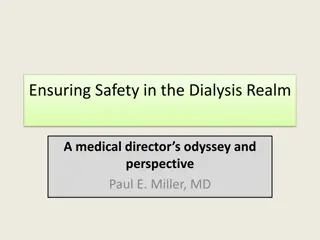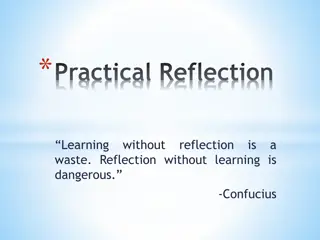Taking Chances: A Reflection on Personal Safety Commitment
Today's presentation prompts reflection on personal safety behavior, emphasizing the importance of upholding safety rules and commitments both at work and in daily life. It underlines the consequences of taking risks and breaking safety protocols, urging individuals to prioritize safety for themselves and others. Through real-life scenarios, it encourages a deep consideration of the gains versus risks involved in compromising safety measures, stressing the significance of a strong personal commitment to prevent accidents.
Download Presentation

Please find below an Image/Link to download the presentation.
The content on the website is provided AS IS for your information and personal use only. It may not be sold, licensed, or shared on other websites without obtaining consent from the author.If you encounter any issues during the download, it is possible that the publisher has removed the file from their server.
You are allowed to download the files provided on this website for personal or commercial use, subject to the condition that they are used lawfully. All files are the property of their respective owners.
The content on the website is provided AS IS for your information and personal use only. It may not be sold, licensed, or shared on other websites without obtaining consent from the author.
E N D
Presentation Transcript
Rolling the Dice -- Gambling with Safety
Todays presentation offers you an opportunity to think about your personal safety behaviour, both on and off the job. We'll talk specifically about taking chances, your personal commitment to safety and what you can do to keep that commitment strong.
Have you ever made a decision to break a safety rule? How long did it take for you to reach that decision? What did you gain by taking a chance? It only takes a moment to decide to break a safety rule, yet that one moment could change your life forever.
Have you been taking chances and getting away with it? Do you always work safely? Are you 100% committed to Don't expect your luck to hold. the safety of yourself, your co- workers, friends, and family? No one ever plans an accident Are there times when your commitment to safety is not as strong as it should be? .
An accident, by definition, is an unplanned event. No one wakes up in the morning and drives to work thinking, "I will have an accident today so I'd better buckle up." No one ever climbs to the very top of a ladder and knows for sure they won't fall.
That's why it's so important to have a personal commitment to safety; a commitment to do the right things to prevent an accident--or minimize the damage done in case an accident does occur. What is gained by taking a chance? Think about a time when you've risked your personal safety. Have you ever bypassed lockout-tag out procedures?
A minute of time, an ounce of convenience? Have you ever driven a car after you had too much to drink? Now honestly ask yourself if those gains were worth it. Have you failed to use fall- protection equipment because it was just too much trouble? Is a little bit of time or convenience really worth chancing electrocution, a car accident, or a bad fall? What did you gain in that situation?
Don't sacrifice your healthy future by taking a chance Every time you're tempted to take a chance with your safety ask yourself if it's really worth the risk. Your family and friends will thank you for making the right decision.
What interferes with your commitment to Safety? Keeping a strong commitment to safety is not easy. Is peer pressure a problem? Do your peers think it's silly to take time for safety? You can set a safe example for your peers.
Consider taking a stand for safety. By committing to safety 100% of the time, you can help reverse the peer pressure that sometimes causes unsafe behaviour. Keep up this exemplary behaviour. Someday you may find that the old peer pressure has given way to something new- the respect of your peers earned by setting a safe example.
It's normal for your commitment to safety to fluctuate. Sometimes it's strong, at other times it's weak. Unfortunately, it tends to be strong just after a close call, or perhaps for a few days after you hear of an accident. Then the commitment wanes, only to be strengthened again by another tragedy. Simply recognizing this pattern can help you avoid it.
Think about your work habits. Have there been times when you're more likely to take a chance? How about those times when you've been extra careful? Did the strength of your safety commitment depend on an outside event-like another person being involved in an accident?
You can keep your commitment to safety strong by remembering the commitment is for you. If you allow things that happen to other people determine the strength of your commitment, it is likely to fluctuate a lot. You can always learn from things that happen to other people, but to keep your commitment strong all the time, stay focused on your personal safety and those things you do that affect it.
Having a personal commitment to safety and keeping it strong are more important than any safety program, procedure, or rule. In fact, programs, procedures, and rules depend on a strong personal commitment to safety.
Ask yourself where you are with your own safety attitude and behaviour. Are you 100% committed to safety, 100% of the time? You are? Great! Need some improvement? Promise yourself to work on it-and keep that promise. You'll be glad you did.























